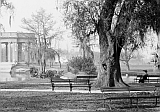|
New Orleans City Park (Images of America) |
|
|
|
~Children & Friends: 1940-2004~ |
||

|
Serious social issues were tackled. A
1949 Supreme Court decision prohibited segregation of the golf course and other facilities – Archbishop Joseph Francis
Rummel canceled the bi-annual Roman Catholic observance of Holy Hour because park commissioners insisted on racially segregated
seating in the stadium. CPIA fought full integration until 1958 when a final court decision mandated that “Negroes are
now permitted to use all park facilities” according to the general manager who added, “we have exhausted every
means to to keep the park segregated” (Times-Picayune, 12-22-1958). Mrs. Henry J. Read, recognizing that
lack of local and state funding had resulted in the park's disrepair, recruited volunteers to organize a fund raiser. From
this effort Friends of City Park was established in 1979. Mrs. Reed was its first president. “Friends” goal was
to initiate programs and organize events to increase public awareness and support for the park.. Its 3,000 members have raised
millions through donations and major fund raisers – Celebration in the Oaks, Lark in the Park, Ghosts in the Oaks, and
Martini Madness. An oak tree has been named in appreciation of Peggy Read's contributions to City Park. During the 1970s
and early 80s the Saux Building operated as Parkway Tavern, a popular but by no means beautiful venue (monkeys were painted
on the window transoms). In 1983 the building was placed on the National Register of Historic Places. After Jack and Martha
Sands renovated it in 1985, they opened Tavern on the Park restaurant. In December, 2003 Ralph Brennan opened Ralph’s
on the Park. In 1971, despite protests and a lawsuit challenging the construction of highways through parkland, work
began on the I-610 which cut through the Couturie Forest. Excavation for the road resulted in a two acre mound 60 feet above
sea-level. It is the highest earthen elevation in New Orleans (Audubon Park's Monkey Hill is 16 feet above sea-level). : :
|
|
|
The images in this book appear courtesy of the New Orleans Public Library (NOPL), Louisiana Digital Library (LDL), the Library of Congress (LOC), The Historic New Orleans Collection (HNOC), Pictometry International (PI), and D.C. "Infrogmation" May (DCM). Unless otherwise noted, images are from the author's collection.
|
||